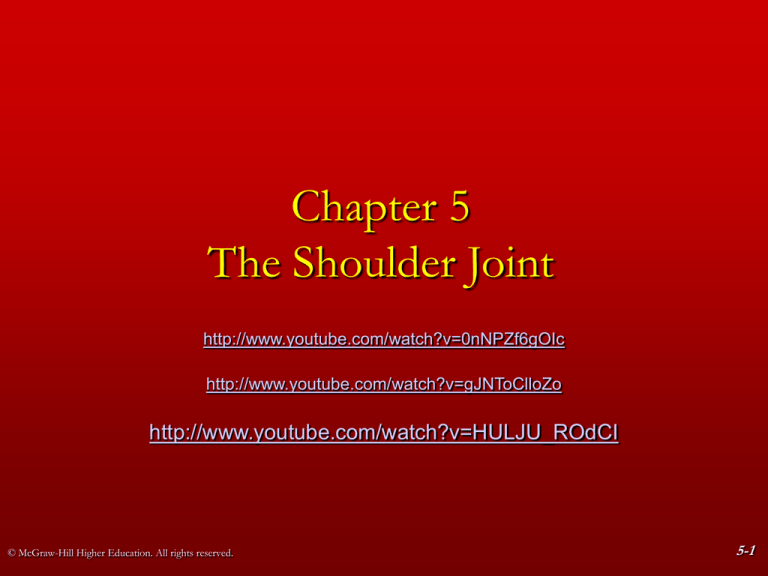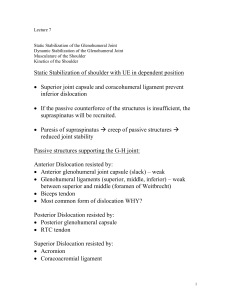
Chapter 5
The Shoulder Joint
http://www.youtube.com/watch?v=0nNPZf6gOIc
http://www.youtube.com/watch?v=gJNToClloZo
http://www.youtube.com/watch?v=HULJU_ROdCI
© McGraw-Hill Higher Education. All rights reserved.
5-1
The Shoulder Joint
• Shoulder joint is attached to axial skeleton
via the clavicle at SC joint
• Scapula movement usually occurs with
movement of humerus
– Humeral flexion & abduction require scapula
elevation, rotation upward, & abduction
– Humeral adduction & extension results in scapula
depression, rotation downward, & adduction
– Scapula abduction occurs with humeral internal
rotation & horizontal adduction
– Scapula adduction occurs with humeral external
rotation & horizontal abduction
© McGraw-Hill Higher Education. All rights reserved.
5-2
The Shoulder Joint
• Wide range of motion of the shoulder joint in
many different planes requires a significant
amount of laxity
• Common to have instability problems
– Rotator cuff impingement
– Subluxations & dislocations
• The price of mobility is reduced stability
• The more mobile a joint is, the less stable it
is & the more stable it is, the less mobile
© McGraw-Hill Higher Education. All rights reserved.
5-3
Bones
• Scapula, clavicle, & humerus serve as
attachments for shoulder joint muscles
– Scapular landmarks
•
•
•
•
•
•
•
•
supraspinatus fossa
infraspinatus fossa
subscapular fossa
spine of the scapula
glenoid cavity
coracoid process
acromion process
inferior angle
© McGraw-Hill Higher Education. All rights reserved.
From Seeley RR, Stephens TD, Tate P: Anatomy and physiology, ed 7, 5-4
New York, 2006, McGraw-Hill
Bones
• Scapula, clavicle, & humerus serve as
attachments for shoulder joint muscles
– Humeral landmarks
•
•
•
•
•
Head
Greater tubercle
Lesser tubercle
Intertubercular groove
Deltoid tuberosity
© McGraw-Hill Higher Education. All rights reserved.
5-5
Bones
• Key bony landmarks
–
–
–
–
–
–
–
Acromion process
Glenoid fossa
Lateral border
Inferior angle
Medial border
Superior angle
Spine of the scapula
© McGraw-Hill Higher Education. All rights reserved.
5-6
Glenohumeral Joint
• multiaxial ball&-socket
• enarthrodial
© McGraw-Hill Higher Education. All rights reserved.
5-7
Glenohumeral Joint
– Glenoid labrum
slightly
enhances
stability
© McGraw-Hill Higher Education. All rights reserved.
5-8
Glenohumeral Joint
– Glenohumeral
ligaments provide
stability
• especially
anteriorly &
inferiorly
• inferior
glenohumeral
ligament
© McGraw-Hill Higher Education. All rights reserved.
5-9
Glenohumeral Joint
– Ligaments are quite lax until extreme
ranges of motion reached due to wide
range of motion involved
– Stability is sacrificed to gain mobility
© McGraw-Hill Higher Education. All rights reserved.
5-10
Glenohumeral Joint
• Determining
exact range of
each
movement is
difficult due to
accompanying
shoulder girdle
movement
© McGraw-Hill Higher Education. All rights reserved.
5-11
Glenohumeral Joint
– 90 to 95 degrees
abduction
– 0 degrees adduction,
75 degrees anterior
to trunk
© McGraw-Hill Higher Education. All rights reserved.
5-12
Glenohumeral Joint
– 40 to 60 degrees of
extension
– 90 to 100 degrees of
flexion
© McGraw-Hill Higher Education. All rights reserved.
5-13
Glenohumeral Joint
– 70 to 90 degrees of internal & external
rotation
© McGraw-Hill Higher Education. All rights reserved.
5-14
Glenohumeral Joint
– 45 degrees of
horizontal
abduction
– 135 degrees of
horizontal
adduction
© McGraw-Hill Higher Education. All rights reserved.
5-15
Glenohumeral Joint
• Frequently injured due to anatomical design
– shallowness of glenoid fossa
– laxity of ligamentous structures
– lack of strength & endurance in muscles
– anterior or anteroinferior glenohumeral
subluxations & dislocations – common
– posterior dislocations – rare
– posterior instability problems somewhat
common
© McGraw-Hill Higher Education. All rights reserved.
5-16
Glenohumeral Joint
• Rotator cuff is frequently injured
– Subscapularis, supraspinatus, infraspinatus, &
teres minor muscles
– attach to the front, top, & rear of humeral head
– point of insertion enables humeral rotation
– vital in maintaining humeral head in correct
approximation within glenoid fossa while more
powerful muscles move humerus through its wide
range of motion
© McGraw-Hill Higher Education. All rights reserved.
5-17
Pairing of shoulder girdle & shoulder joint
movements
Shoulder joint
Abduction
Adduction
Flexion
Extension
Internal rotation
External rotation
Horizontal abduction
Horizontal adduction
© McGraw-Hill Higher Education. All rights reserved.
Shoulder girdle
Upward rotation
Downward rotation
Elevation/upward rotation
Depression/downward rotation
Abduction (protraction)
Adduction (retraction)
Adduction (retraction)
Abduction (protraction)
5-18
Movements
• Abduction
– upward lateral
movement of humerus
out to the side, away
from body
• Adduction
– downward movement
of humerus medially
toward body from
abduction
© McGraw-Hill Higher Education. All rights reserved.
5-19
Movements
• Flexion
– movement
of humerus
straight
anteriorly
• Extension
– movement
of humerus
straight
posteriorly
© McGraw-Hill Higher Education. All rights reserved.
5-20
Movements
• Horizontal adduction
(transverse flexion)
– movement of humerus in a
horizontal or transverse
plane toward & across chest
• Horizontal abduction
(transverse extension)
– movement of humerus in a
horizontal or transverse
plane away from chest
© McGraw-Hill Higher Education. All rights reserved.
5-21
Movements
• External rotation
– movement of
humerus laterally
around its long axis
away from midline
• Internal rotation
– movement of
humerus medially
around its long axis
toward midline
© McGraw-Hill Higher Education. All rights reserved.
5-22
Movements
• Diagonal abduction
– movement of humerus
in a diagonal plane
away from midline of
body
• Diagonal adduction
– movement of humerus
in a diagonal plane
toward midline of body
© McGraw-Hill Higher Education. All rights reserved.
5-23
Muscles
• Intrinsic glenohumeral muscles
– Originate on scapula & clavicle
– Deltoid, Coracobrachialis, Teres major
– Rotator cuff group
• subscapularis, supraspinatus, infraspinatus, &
teres minor
• Extrinsic glenohumeral muscles
– latissimus dorsi & pectoralis major
© McGraw-Hill Higher Education. All rights reserved.
5-24
Muscles
• Anterior
– Pectoralis major
– Coracobrachialis
– Subscapularis
• Superior
– Deltoid
– Supraspinatus
© McGraw-Hill Higher Education. All rights reserved.
From Shier D, Butler J, Lewis R: Hole’s essentials of human anatomy and physiology, ed 9,
New York, 2006, McGraw-Hill.
5-25
Muscles
• Superior
– Deltoid
– Supraspinatus
• Posterior
–
–
–
–
Latissimus dorsi
Teres major
Infraspinatus
Teres minor
© McGraw-Hill Higher Education. All rights reserved.
From Shier D, Butler J, Lewis R: Hole’s
essentials of human anatomy and
physiology, ed 9, New York, 2006,
McGraw-Hill.
5-26
Deltoid Muscle
Anterior fibers:
abduction, flexion,
horizontal adduction,
& internal rotation
Posterior fibers:
abduction, extension,
horizontal abduction,
& external rotation
Middle fibers:
abduction
© McGraw-Hill Higher Education. All rights reserved.
5-27
Pectoralis Major Muscle
Upper fibers (clavicular head):
internal rotation, horizontal
adduction, flexion, abduction (once
arm is abducted 90 degrees, upper
fibers assist in further abduction), &
adduction (with arm below 90
degrees of abduction)
Lower fibers (sternal
head): internal
rotation, horizontal
adduction, extension,
& adduction
© McGraw-Hill Higher Education. All rights reserved.
5-28
Latissimus Dorsi Muscle
Adduction
Extension
Internal rotation
Horizontal abduction
© McGraw-Hill Higher Education. All rights reserved.
5-29
Coracobrachialis Muscle
Flexion
Adduction
Horizontal adduction
© McGraw-Hill Higher Education. All rights reserved.
5-30
Rotator cuff muscles
• Supraspinatus
– attach to greater tubercle from above (Abduct)
• Infraspinatus
– attach to greater tubercle posteriorly (Ext. Rot.)
• Teres Minor
– attach to greater
tubercle posteriorly
(Ext. Rot.)
• Subscapularis
– attach to lesser
tubercle anterior (Int.
Rot.)
© McGraw-Hill Higher Education. All rights reserved.
5-31
Rotator cuff muscles
• not very large
• must possess strength & muscular endurance
• conducting repetitious overhead activities
(throwing, swimming, & pitching) with poor
technique, muscle fatigue, or inadequate warmup & conditioning leads to failure of rotator cuff
muscle group in dynamically stabilizing humeral
head in glenoid cavity
• leads to further rotator cuff problems such as
tendinitis & rotator cuff impingement within
subacromial space
© McGraw-Hill Higher Education. All rights reserved.
5-32
Subscapularis Muscle
Internal rotation
Adduction
Extension
Stabilization of the
humeral head in
glenoid fossa
© McGraw-Hill Higher Education. All rights reserved.
5-33
Supraspinatus Muscle
Abduction
Stabilization of the
humeral head in
glenoid fossa
© McGraw-Hill Higher Education. All rights reserved.
5-34
Infraspinatus Muscle
External rotation
Horizontal abduction
Extension
Stabilization of humeral
head in the glenoid fossa
© McGraw-Hill Higher Education. All rights reserved.
5-35
Teres Minor Muscle
External rotation
Horizontal abduction
Extension
Stabilization of humeral
head in the glenoid fossa
© McGraw-Hill Higher Education. All rights reserved.
5-36
Teres Major Muscle
Extension, particularly from
the flexed position to the
posteriorly extended
position
Internal rotation
Adduction, particularly from
the abducted position
down to the side &
toward midline of body
© McGraw-Hill Higher Education. All rights reserved.
5-37
Glenohumeral Flexion
• Agonists
– Anterior Deltoid
– Upper Pectoralis Major
© McGraw-Hill Higher Education. All rights reserved.
5-38
Glenohumeral Extension
• Agonists
– Teres
Major
– Latissimus
Dorsi
– Lower
Pectoralis
Major
© McGraw-Hill Higher Education. All rights reserved.
5-39
Glenohumeral Abduction
• Agonists
– Deltoid
– Supraspinatus
– Upper Pectoralis
Major
© McGraw-Hill Higher Education. All rights reserved.
5-40
Glenohumeral Adduction
• EX. Lat. Pull pull down
weights
• Agonists
– Latissimus
Dorsi
– Teres Major
– Lower
Pectoralis
Major
© McGraw-Hill Higher Education. All rights reserved.
5-41
Glenohumeral Internal Rotation
• Agonists
– Latissimus
Dorsi
– Teres Major
– Subscapularis
– Pectoralis
Major
• All attach
anteromedially
on humerus
© McGraw-Hill Higher Education. All rights reserved.
5-42
Glenohumeral External Rotation
• Agonists
– Infraspinatus
– Teres Minor
• Both attach
posteriorly on
greater tubercle
© McGraw-Hill Higher Education. All rights reserved.
5-43
Glenohumeral Horizontal Abduction
• Agonists
– Posterior
Deltoid
– Middle
Deltoid
– Infraspinatus
– Teres Minor
© McGraw-Hill Higher Education. All rights reserved.
5-44
Glenohumeral Horizontal Adduction
• Agonists
– Anterior Deltoid
– Pectoralis Major
– Coracobrachialis
© McGraw-Hill Higher Education. All rights reserved.
5-45
Glenohumeral Diagonal Abduction
• Agonists
– Posterior Deltoid
– Infraspinatus
– Teres Minor
– Triceps Brachii
(Long Head)
© McGraw-Hill Higher Education. All rights reserved.
5-46
Glenohumeral Diagonal Adduction
• Agonists - both
low & high
– Anterior Deltoid
– Coracobrachialis
– Biceps Brachii
(short head)
– Pectoralis Major Upper & Lower
© McGraw-Hill Higher Education. All rights reserved.
5-47
Nerves
• All shoulder joint muscles are innervated from
the brachial plexus
• Lateral pectoral nerve arising from C5, C6, &
C7
– Pectoralis major (clavicular head)
• Medial pectoral nerve arising from C8 & T1
– Pectoralis major (sternal head)
• Thoracodorsal nerve arising from C6, C7, &
C8
– Latissimus dorsi
© McGraw-Hill Higher Education. All rights reserved.
5-48
Nerves
• Axillary nerve branching
from C5 & C6
– Deltoid
– Teres minor
– Sensation to lateral patch of
skin over deltoid region of
arm
• Upper subscapular nerves
arising from C5 & C6
– Subscapularis
© McGraw-Hill Higher Education. All rights reserved.
5-49
Nerves
• Lower subscapular nerve arising from
C5 & C6
– Subscapularis
– Teres major
• Suprascapula nerve originating from
C5 & C6
– Supraspinatus
– Infraspinatus
© McGraw-Hill Higher Education. All rights reserved.
5-50
Nerves
• Musculotaneous nerve
branching from C5, C6, &
C7
– Coracobrachialis
– Sensation to radial aspect
of forearm
© McGraw-Hill Higher Education. All rights reserved.
5-51






